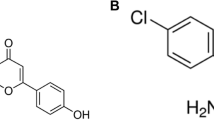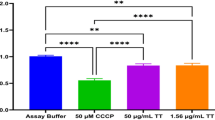Abstract
Toxoplasma gondii is a ubiquitous intracellular zoonotic parasite estimated to affect about 30–90% of the world’s human population. The most affected are immunocompromised individuals such as HIV-AIDS and cancer patients, organ and tissue transplant recipients, and congenitally infected children. No effective and safe drugs and vaccines are available against all forms of the parasite. We report here the antagonistic and indifferent activity of the combination of five different formulations of pure synthetic 3-deoxyanthocyaninidin (3-DA) chloride compounds against T. gondii tachyzoites and the synergistic and additive interaction against a human foreskin fibroblast (HFF) cell line in vitro using fluorescence microscopy, trypan blue assay, and fractional inhibitory concentration index. The individual and the combined pure 3-DA compounds were observed to have effective inhibition against T. gondii parasites with less cytotoxic effect in a ratio of 1:1. The IC50 values for parasite inhibition ranged from 1.88 μg/mL (1.51–2.32 μg/mL) for luteolinindin plus 7-methoxyapigeninindin (LU/7-MAP) and 2.23 μg/mL (1.66–2.97 μg/mL) for apigeninindin plus 7-methoxyapigeninindin (AP/7-MAP) combinations at 95% confidence interval (CI) after 48 h of culture. We found LU/7-MAP to be antagonistic and AP/7-MAP to be indifferent in interaction against T. gondii growth. Both individual and combination 3-DA compounds not only depicted very strong inhibitory activity against T. gondii, but also had synergistic and additive cytotoxic effects against HFF cells. These synthetic 3-DAs have potential as antiparasitic agents for the treatment of human toxoplasmosis.












Similar content being viewed by others
References
Abugri DA, Witola WH, Jaynes JM, Toufic N (2016) In vitro activity of Sorghum bicolor extracts, 3-deoxyanthocyanidins, against Toxoplasma gondii. Exp Parasitol 164:12–19
Aida Y, Tamogami S, Kodama O, Tsukiboshi T (1996) Synthesis of 7-methoxyapigeninidin and its fungicidal activity against Gloeocercospora sorghi. Biosci Biotechnol Biochem 60(9):1495–1496
Andrade RM, Chaparro JD, Capparelli E, Reed SL (2014) Auranofin is highly efficacious against Toxoplasma gondii in vitro and in an in vivo experimental model of acute toxoplasmosis. PLoS Negl Trop Dis 8(7):e2973
Ayuba GI, Jensen GS, Benson KF, Okubena AM, Okubena O (2014) Clinical efficacy of a West African Sorghum bicolor-based traditional herbal preparation Jobelyn shows increased hemoglobin and CD4+ T-lymphocyte counts in HIV-positive patients. J Altern Complement Med 20(1):53–56
Barbee LA, Soge OO, Holmes KK, Golden MR (2014) In vitro synergy testing of novel antimicrobial combination therapies against Neisseria gonorrhoeae. J Antimicrob Chemother 69(6):1572–1578
Beaman MH, McCabe RE, Wong S-Y, Remington JS (1995) Toxoplasma gondii. In: Mandell GL, Douglas RG Jr, Bennett JE (eds) Principle and practice of infectious diseases, vol 2, 4th edn. Chuchhill Livingston, New York, pp 2455–2475PP
Brooks RG, Remington JS, Luft BJ (1987) Drug used in the treatment of toxoplasmosis. In: Peterson PK, Verhoef J (eds) The antimicrobial agents annual II. Elsevier/th-Holland Publishing Co, Amsterdam, pp 297–306
Chamberland S, Kirst HA, Current WL (1991) Comparative activity of macrolides against Toxoplasma gondii demonstrating utility of an in vitro microassay. Antimicrob Agents Chemother 35(5):903–909
Dannemann B, McCutchan JA, Israelski D, Antoniskis D, Leport C, Luft B, Nussbaum J, Clumeck N, Morlat P, Chiu J, Vilde JL (1992) Treatment of toxoplasmic encephalitis in patients with AIDS. A randomized trial comparing pyrimethamine plus clindamycin to pyrimethamine plus sulfadiazine. Ann Intern Med 116(1):33–43
Devi PS, Saravanakumar M, Mohandas S (2011) Identification of 3-deoxyanthocyanins from red sorghum (Sorghum bicolor) bran and its biological properties. Afr J Pure Appl Chem 5(7):181–193
Florento L, Matias R, Tuaño E, Santiago K, Dela Cruz F, Tuazon A (2012) Comparison of cytotoxic activity of anticancer drugs against various human tumor cell lines using in vitro cell-based approach. Int J Biomed Sci 8(1):76–80
Fomovska A, Huang Q, Bissati KEI, Mui EJ, Witola WH, Cheng G, Zhou Y, Sommerville C, Roberts CW, Bettis S, Prigge ST, Afanador GA, Hickman MR, Lee PJ, Lead SE, Auschwitz JM, Pieroni M, Stec J, Muench SP, Rice DW, Kozikowski AP, McLead R (2012) Novel N-benzoyl-2-hydroxybenzamide disrupts unique parasite secretory pathway. Antimicrob Agents Chemother 56(5):2666–2682
Frenkel JK (1971) Toxoplasmosis: mechanisms of infection, laboratory diagnosis and management. Curr Top Pathol 54:28–75
Gorka AP, Jacobs LM, Roepe PD (2013) Cytostatic versus cytocidal profiling of quinolone drug combinations via modified fixed-ratio isobologram analysis. Malar J 12:332
Gubbels MJ, Li C, Striepen B (2003) High-throughput growth assay for Toxoplasma gondii using yellow fluorescent protein. Antimicrob Agents Chemother 47:309–316
Khan AA, Slifer T, Araujo FG, Polzer RJ, Remington JS (1997) Activity of trovafloxacin in combination with other drugs for treatment of acute murine toxoplasmosis. Antimicrob Agents Chemother 41(5):893–897
Lehane AM, Saliba K (2008) Common dietary flavonoids inhibit the growth of the intraerythrocytic malaria parasite. BMC Res Notes 1(26):1–5
Leport C, Raffi F, Matheron S, Katlama C, Regnier B, Saimot AG, Marche C, Vedrenne C, Vilde JL (1988) Treatment of central nervous system toxoplasmosis with pyrimethanie/sulfadiazine combination in 35 patients with the acquired immunodeficiency syndrome: efficacy of long-term continuous therapy. Am J Med 84(1):94–100
Luft BJ, Remington JS (1988) AIDS commentary: toxoplasmic encephalitis. J Infect Dis 157(1):1–6
Luft BJ, Remington JS (1994) Toxoplasmosis. In: Hoeprich PD, Jorden MC, Ronald AR (eds) Infectious diseases. A treatise of infectious processes, 5th edn. JB Lippincott Co, Philadelphia, pp 1201–1213
McLeod R, Khan AR, Noble GA, Latkany P, Jalbrzikowski J, Boyer K, Toxoplasmosis Study Group (2006) Severe sulfadiazine hypersensitivity in a child with reactivated congenital toxoplasmic chorioretinitis. Pediatr Infect Dis J 25:270–272
Odds FC (2003) Synergy, antagonism, and what the chequerboard puts between them. J Antimicrob Chemother 52:1
Paulus W (1993) Microbicides for the protection of materials—a handbook. Chapman and Hall, London, p 496
Romand S, Pudney M, Derouin F (1993) In vitro and in vivo activities of the hydroxynaphthoquinone atovaquone alone or combined with pyrimethamine, sulfadiazine, clarithromycin, or minocycline against Toxoplasma gondii. Antimicrob Agents Chemother 37(11):2371–2378
Schoondermark-Van de Ven E, Melchers W, Camps W, Eskes T, Meuwissen J, Galama J (1994) Effectiveness of spiramycin for treatment of congenital Toxoplasma gondii infection in rhesus monkeys. Antimicrob Agents Chemother 38(9):1930–1936
Shih CH, Siu SO, Ng R, Wong E, Chiu LC, Chu IK, Lo C (2017) Quantitative analysis of anticancer 3-deoxyanthocyanidins in infected Sorghum seedlings. J Agric Food Chem 55(2):254–259
Tee GH, Khairul AA, Rohela M, Rahmah N (1998) In vitro evaluation of various drugs against Toxoplasma gondii. Med J Malaysia 53(2):175–180
Tenant-Flowers M, Boyle MJ, Carey D, Marriot DJ, Harkness JL, Penny R, Cooper DA (1991) Sulphadiazine desensitization in patients with AIDS and cerebral toxoplasmosis. AIDS 5:311–315
Yang L, Browning JD, Awika JM (2009) Sorghum 3-deoxyanthocyanins possess strong phase II enzyme inducer activity and cancer cell growth inhibition properties. J Agric Food Chem 57(5):1797–1804
Acknowledgements
We are grateful to the Department of Chemistry, Tuskegee University, for their support. In addition, we wish to acknowledge the RCMI core lab team and grant number G12MD007585-23 for their support in the microscopy work. We thank Peak Serum for providing us with optimal original fetal bovine serum.
Author information
Authors and Affiliations
Corresponding author
Ethics declarations
Conflict of interest
The authors declare that they have no conflict of interest.
Rights and permissions
About this article
Cite this article
Abugri, D.A., Witola, W.H. & Jaynes, J.M. In vitro antagonistic and indifferent activity of combination of 3-deoxyanthocyanidins against Toxoplasma gondii . Parasitol Res 116, 3387–3400 (2017). https://doi.org/10.1007/s00436-017-5661-1
Received:
Accepted:
Published:
Issue Date:
DOI: https://doi.org/10.1007/s00436-017-5661-1




